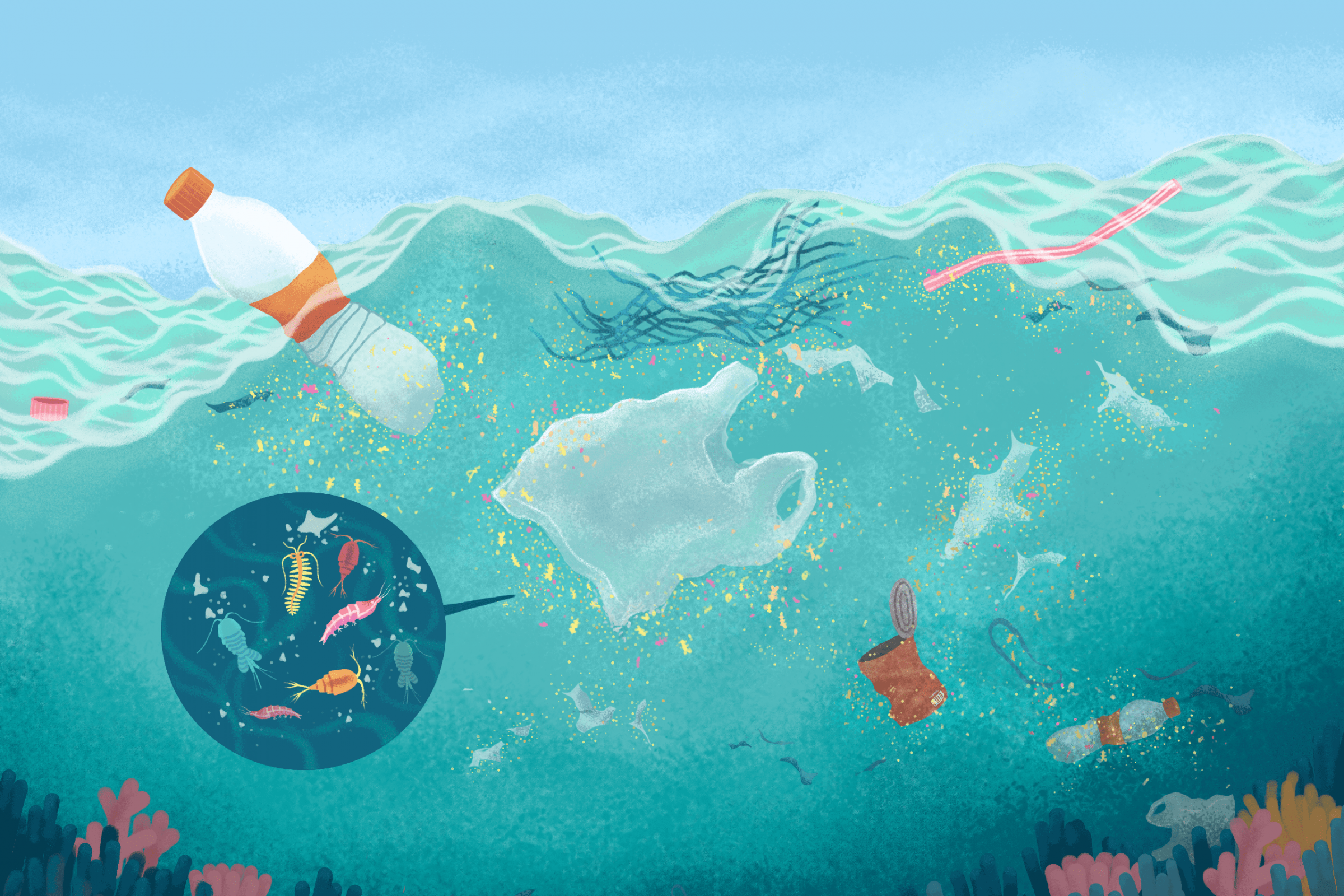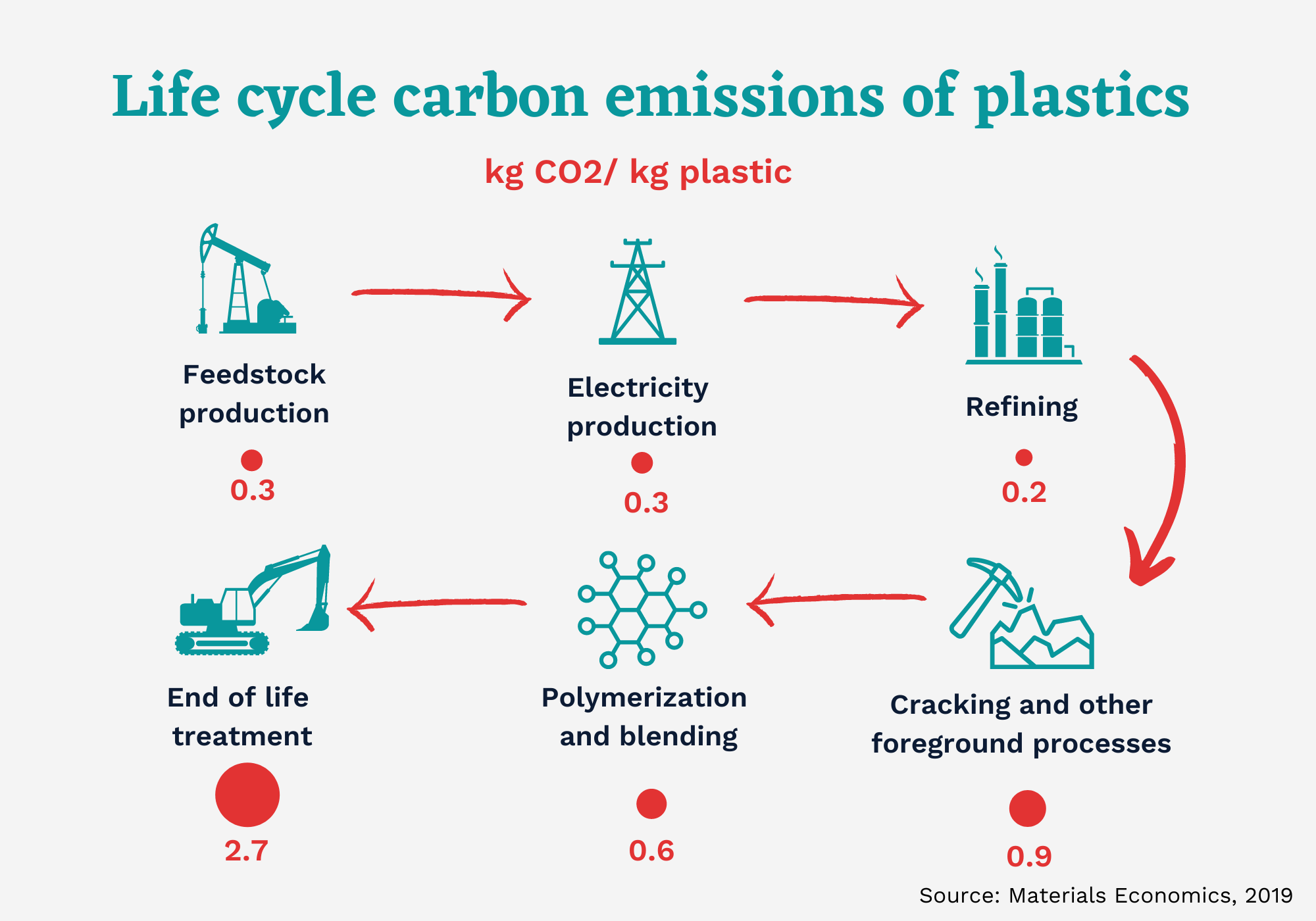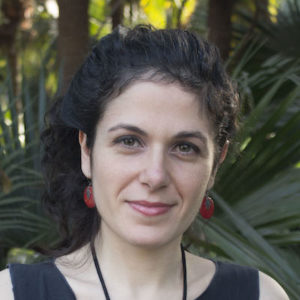From production to disposal, plastic emits huge amounts of greenhouse gas. Plastic waste may even be interfering with the ocean’s ability to absorb carbon

Plastic’s carbon footprint has doubled in less than 30 years, now accounting for nearly 5% of total annual greenhouse gas emissions. (Illustration: Neutron T / China Dialogue Ocean)
Lou Del Bello
July 11, 2022
With sea level rise and ecological collapse threatening its environment and the very existence of its main coastal cities, Southeast Asia is one of the regions most at risk from the impacts of climate change. But while countries around the world step up efforts towards decarbonisation and reaching their shared climate goals, carbon remains unchallenged and firmly entrenched in the region’s economy – in the form of plastic.
From production to consumption and disposal, plastic is one of the planet’s most carbon-intensive industries. Scientists have found its carbon footprint has doubled in less than 30 years, now accounting for nearly 5% of total annual greenhouse gas emissions. If plastics were a country, they would be the fifth largest emitter in the world. Yet petrochemicals, the refined oil and gas products that plastic production relies on, have been labelled an “energy blind spot” – a sector that policymakers consistently neglect in the drive towards decarbonisation.
For the countries of Southeast Asia, plastic is becoming an ever thornier issue, as the region confronts a growing tide of waste from home and abroad that threatens its environment and, as it degrades or is incinerated, even the global climate.
The journey of plastics in Southeast Asia
While public debate tends to focus on plastic waste and the emissions it generates when incinerated, the material’s climate impacts start at the very beginning of the supply chain. Plastics are derived from fossil fuels, which are also used to run the industrial plants that produce plastics.
“The climate impacts of plastic occur at multiple stages in its lifecycle,” says Carroll Muffett, president and CEO of the non-profit Center for International Environmental Law (CIEL). “Plastics can be made from naphtha, a byproduct of oil production. It can be made from ethane, a byproduct of natural gas, or even directly from coal through a process called coal-to-olefins,” Muffett explains.
The climate impacts of plastic are largely invisible because they occur upstreamCarroll Muffett, Center for International Environmental Law
The journey of plastic production starts at wellheads and drill pads, and continues through pipelines and corridors built to transport fuels, all of which release methane and other pollutants along the way. “Many of those impacts are largely invisible because they occur upstream,” Muffett says, “and are driven in different ways in different regions of the world”.
Take Indonesia, which relies on coal for 60% of its electricity production. There, a growth in plastic production has exacerbated carbon emissions and particulate matter pollution from coal burning. In Indonesia, coal mining activity for plastics production specifically has boomed since 1995, with researchers noting a 300-fold increase by 2015. As a result, they calculate that more than one-tenth of Indonesia’s total emissions can be attributed to the plastics industry.
Indonesia also finds itself in trouble at the other end of the plastic life cycle, as a leading source of marine plastic pollution. As plastic debris is blown by wind or washed away by rain into sewers and waterways across the world’s coastal areas, it may end up in the sea, globally adding an estimated 14 million tonnes of waste to the ocean every year. In Indonesia, more than 4,000 fish species and 12 million people employed in the fishing industry bear the brunt of this problem.
Plastics choke the ocean
While grim images of trapped turtles and fish carcasses full of plastic may be the most vivid depiction of the global ocean plastics problem, a growing body of research now suggests that the smallest marine creatures at the bottom of the food chain may in fact be worst hit.
A research team at the GEOMAR Helmholtz Centre for Ocean Research Kiel in Germany modelled a hypothetical ocean system in which a menagerie of marine grazers and predators, known as zooplankton, continue to feed on the microplastics of 5mm or less that increasingly pollute the ocean. Their modelling found that as these materials enter zooplankton diets and increasingly replace the carbon-containing organisms on which they normally feed, this process could potentially accelerate the loss of oxygen in the oceans, and contribute to climate change.

Plastic waste in Jimabaran Bay, Bali, Indonesia. Huge quantities of plastic waste end up in the ocean, harming marine life. (Image: Domonabikebali / Alamy)
“The effect on oxygen and the carbon cycle I reported in my paper has not been observed in the real ocean yet,” cautions lead author Karin Kvale. “It’s reasonable to expect that the severity of ecosystem damage will depend on how much the plastic overlaps with the biology, so biologically productive coastal areas with large human populations could be expected to suffer larger negative ecological effects.”
While the potential impacts of these feeding changes could be particularly brutal for the densely populated and highly biodiverse coasts of Indonesia, and Southeast Asia at large, according to Moffatt these scarcely understood risks matter to the whole planet. Oceanic microflora and fauna are “at the heart of the biological carbon pump responsible for moving CO2 from the ocean surface to the ocean depths, where it doesn’t interact with the climate over centuries or millennia,” he says. “This enormous quantity of plastic in the ocean could actually be interfering with the world’s single largest natural carbon sink.”
Measuring emissions from plastic
For developing countries in South and Southeast Asia, curbing the pervasive impacts of plastic pollution is as difficult on solid ground as it is at sea.
In most countries in the region, including Thailand and Vietnam, the bulk of plastic waste is processed by informal workers who pick out whatever can be recycled, while the rest goes to dumping sites to eventually end up in landfill or incinerators. How much methane and other harmful emissions are released in these processes is difficult to estimate.
Data on emissions at different stages of the plastic life cycle exist, but they are scattered and can be inconsistent. Campaigners at Pacific Environment, a California-based non-profit, decided to try and come up with their own simple model to calculate carbon emissions from the plastic sector at large, starting with China.
The researchers used data from a private provider specialising in industrial sector intelligence “to figure out how much plastic was being produced in the country, and particularly how much single-use plastic, for which we used a proxy of ‘plastic in the packaging sector’,” says Nicole Portley, who leads marine campaigns for Pacific Environment. “And then we used data from the consultancy Material Economics on the life-cycle release of CO2-equivalent emissions for each kilogram of plastic – about 5 kg of CO2 equivalent – to estimate the emissions resulting from China’s plastic production and consumption.”

Graphic by China Dialogue Ocean
The analysis, the full results of which are yet to be published, shows how estimating the plastic flows within a single country can be relatively easy with available data, but things get much more complex when it comes to international trade, which generates a huge amount of plastic, much of which is non-recyclable packaging.
The threat beyond borders
In Southeast Asia, the single-use packaging that many companies use to deliver their products to the consumer is “a significant problem”, says Von Hernandez, global coordinator for Break Free from Plastic, a movement to end plastic pollution. “We find that a lot of the plastic waste that’s ending up in the oceans or in the open environment is not recyclable.”
This type of delivery model was pioneered in South and Southeast Asia, and has become so “entrenched” that big industries now use it as a “justification”. Hernandez, who is a renowned Filipino environmentalist and Goldman Prize winner, adds that these actors defend single-use plastics by claiming they are “supporting the poor, because people need access to certain luxury goods.”
A lot of the plastic waste that’s ending up in the oceans or in the open environment is not recyclableVon Hernandez, global coordinator of Break Free from Plastic
Hoang Hai, a researcher at the University of Da Nang in Vietnam, surveyed 307 households in the city of Da Nang as part of a research project in collaboration with the Norwegian Institute for Water Research (NIVA). Their study demonstrates that the use of disposable plastics in the city is ubiquitous, and dramatically increasing due to the growth of app-based food and drink delivery services. The surveyed households chose home delivery due to its convenience, in terms of avoiding cooking and washing up. But these options exacerbate the plastic waste problem. “This lifestyle will generate [per person] hundreds of plastic bags, cups, boxes, and straws to be disposed of,” says Hoang.
Hernandez points out that companies are starting to take notice of the issue. Nestlé, which generates nearly 2 million tonnes of plastic waste annually and has been identified as one of the major players responsible for a high share of imported plastic waste in Southeast Asia, has set a net-zero greenhouse gas emissions target by 2050. A company spokesperson told this reporter that this will include both direct and indirect emissions, the majority of which come from agriculture, packaging and product distribution.
The company has also committed that by 2025, all its packaging will be recyclable and reusable, but pointed out that some countries may not have the necessary infrastructure for collection and recycling, Nestlé is exploring removing plastic packaging altogether and is rolling out initiatives in the Philippines, Malaysia and Thailand.
Waste management
Southeast Asian countries are among the nations that stand to lose the most from plastic pollution, and from the climatic impacts it contributes to. But they are not the biggest producers of plastic items, nor of plastic waste. The United States and United Kingdom are by far the biggest per capita waste producers, at 0.34 kg and 0.21 kg respectively each day. The only Southeast Asian country that makes it into the top ten is the Philippines, with 0.07 kg per person.
Properly managing plastic waste, however, is a different issue, and one made more complex for Southeast Asian nations that accept waste shipped from other countries. The problem has become more acute after China, historically one of the biggest importers of recyclable scrap materials, enforced a ban on foreign waste in 2018.
Following China’s new restrictions, smaller countries in the region have been absorbing the waste influx. An analysis by Greenpeace Southeast Asia found that the 10 countries that form ASEAN (the Association of Southeast Asian Nations) recorded a 171% growth in plastic waste imports, rising from a total of 836,500 tonnes in 2016 to 2,266,000 tonnes to 2018, the year the ban was implemented.
Developing countries struggle to manage waste, whether imported or domestic, because they lack the infrastructure to process it or incinerate it safely. “Mismanaged” plastic waste is that which ends up in the environment, instead of being incinerated, properly buried or otherwise safely dealt with. Researchers have calculated that in 2019 the amount of mismanaged plastic waste in the United States and the UK was 0.81 and 0.44 kg per person respectively. But for the Philippines, which produces far less waste, the count was 37.23 kg per person.
Much of this mismanaged plastic ends up in water sources and, ultimately, in the ocean. Out of the top ten rivers releasing debris into the ocean, seven are in the Philippines, with the Pasig River that cuts through the capital Manila accounting for 6.4% of the total alone.
Emissions from plastics discarded in the environment are hard to measure, but mounting evidence suggests they are higher than previously thought. “Research shows that plastics at the surface of the ocean continuously release gases such as methane and ethylene, and other greenhouse gases,” CIEL’s Carroll Moffatt says, pointing to a study in the journal PLoS.
“I think the really troubling part of this is that plastics in the ocean are outweighed by plastics in the terrestrial environment,” he adds. “Those plastics, because they’re exposed to [more] sunlight, are going to be emitting methane and other greenhouse gases at an even faster rate than the plastics in the ocean.”
Future action against plastic pollution
Experts agree that curbing emissions from the plastic sector requires action on the ground as well as at a governmental and global level.
For now, no Southeast Asian nations have included plastic management in their climate pledges under the Paris Agreement. But ASEAN countries have a five-year plan in place to tackle marine plastic pollution, which aims to reduce the amount of waste, improve collection and create value for waste reuse.
Nicole Portley says that while there is some action on the policy front, “in our opinion it is not fast or comprehensive enough.” She mentions Vietnam’s recently enacted framework which makes producers pay for their waste and could incentivise packaging redesign, and points to the Philippines as a “standout” in the region for having outlawed incineration.
“We’d love to also see policy action on curbing plastic supply. There is a global treaty in the works through the UN, and we’ll see if it would place any limits on supply,” Portley adds. A resolution to establish a UN treaty to end global plastic pollution was passed at the UN Environment Assembly in Nairobi this March, and was seen by many as a giant stride towards eliminating plastic waste.
This article was first published by China Dialogue Ocean, and is a collaboration with the China Environment Forum’s Turning the Tide on Plastic Waste in Asia initiative. Read more plastic pollution articles and webinars from the Wilson Center here.
CHARTS AND MULTIMEDIA

Lou Del Bello
Lou is author of Lights On, a weekly newsletter. Previously, she has worked as environment correspondent for Bloomberg in Delhi and a freelance science writer for the BBC, Undark, Nature News, New Scientist and more. She holds masters degrees in Semiotics from the University of Bologna in Italy and Science Journalism from City University London. She tweets at @loudelbello
No comments:
Post a Comment